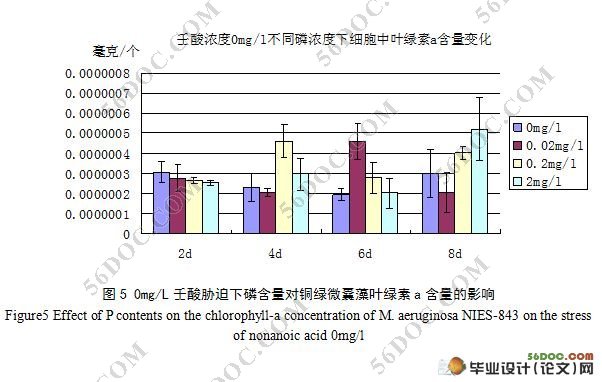水体P含量对铜绿微囊藻抵抗壬酸胁迫的影响
来源:wenku163.com 资料编号:WK1634688 资料等级:★★★★★ %E8%B5%84%E6%96%99%E7%BC%96%E5%8F%B7%EF%BC%9AWK1634688
资料介绍
水体P含量对铜绿微囊藻抵抗壬酸胁迫的影响(8300字)
摘 要:壬酸是一种对水华蓝藻有较强的抑制效应的生物源物质。水体氮含量是导致水体富营养化和蓝藻水华的主要因素之一。本研究探讨了不同P浓度下铜绿微囊藻抵抗壬酸胁迫的影响。实验结果表明,在壬酸浓度为0mg/l时细胞数量可能会因为养料的不足而呈现减少的趋势。在壬酸浓度为2mg/l时细胞数量随着时间和磷浓度的增加而增加。而叶绿素a和类胡萝卜素的含量和壬酸0mg/l时并没有明显区别。在壬酸浓度为4mg/l时虽然细胞数量也是随着时间和磷浓度的增加而增加,可是细胞的数量明显没有壬酸浓度为2mg/l时多。在壬酸浓度为8mg/l时细胞数量有明显减少之后又有回升。
关键词:蓝藻;壬酸;磷;生长;光合色素
The effect of P concentration on the resistant ability of Microcystis aeruginosa to the stress of nonanoic acid
Abstract: Nonanoic acid is a kind of biogenic substances which has strong inhibitory effect of cyanobacteria bloom. Water Nitrogen content is causing eutrophication and cyanobacterial bloom in one of the main factors.This study examines the resistance of Microcystis aeruginosa in different P concentration effect of nonanoic acid stress.Experimental results show that in 0mg/l of pelargonic acid concentration cell number may be rendered down trend because of insufficient nourishment.Under the circumstances of chlorophyll and carotenoid content unchanged, the cell number volume increases along with the increase in phosphorus concentration over time when the Nonanoic acid concentration is 2mg/l.Although the cell number volume increases in pace with the increase in phosphorus concentration over time when the Nonanoic acid concentration is 2mg/l, the 4mg/l concentration cell number is much less than 2mg/l concentration of cell quantity.Under 8mg/l nonanoic acid concentration cell number has declined significantly later the rise occured.
Key words: Algae; Nonanoic acid; P; Growth; Photosynthetic pigment

目 录
摘要 1
关键词 1
1 前言 2
2 材料与方法 4
2.1 供试藻种 4
2.2 实验主要仪器设备 4
2.3 实验主要药剂 4
2.4 藻类培养基的配制 5
2.4.1 培养基成分 (1L含量) 5
2.4.2 配制方法 6
2.5 铜绿微囊藻的扩大培养 6
2.4 实验处理 6
2.4.1器皿准备 6
2.4.2 接种藻种 7
2.4.3 细胞计数 7
2.4.4 测量色素含量 7
3 实验结果与分析 8
3.1培养基中P含量对铜绿微囊藻生长的影响 8
4.2 叶绿素A含量的变化 10
4.3类胡萝卜素含量的变化 12
5 讨论 15
参考文献 16
致谢 17
|



